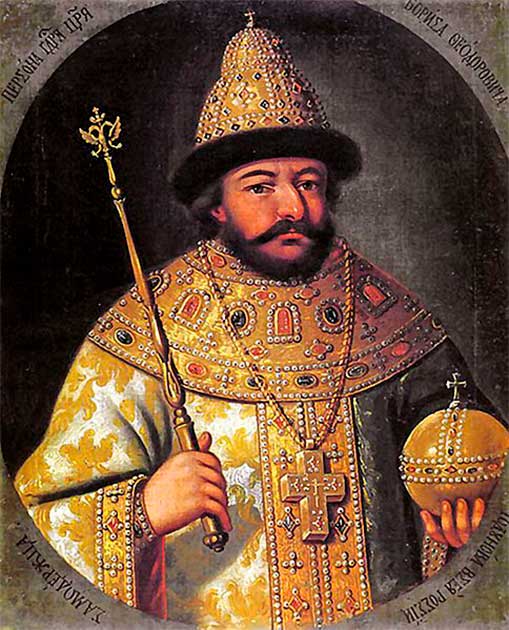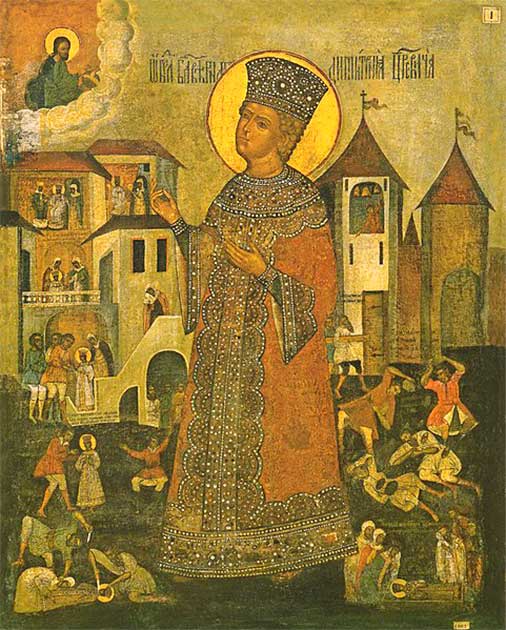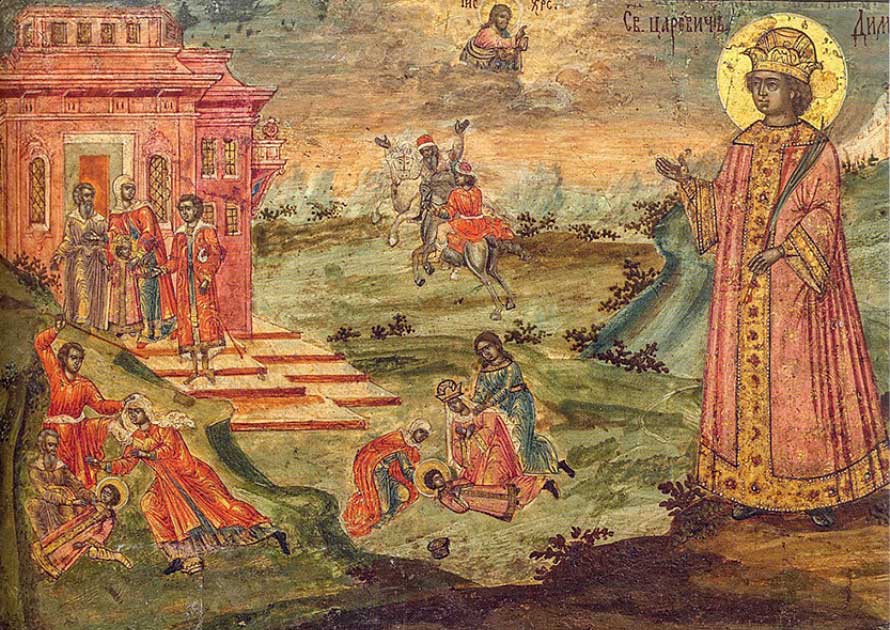When a king dies, their firstborn son, the heir, takes up the throne in his father’s stead. It sounds easy enough, but the royal succession was more complex.
Before modern medicine, many children did not live long enough to become the next ruler. The title of heir then will go to the king’s second-born son, and so on.
What happens if there are no other heirs? Uncertainty about who will become the next ruler, and many power-hungry people made sure they would be the next ruler, no matter what.
People will do the craziest things, and after Tsar Feodor I, Ivan the Terrible’s sole surviving son, died, there was a Tsar-sized hole in the country that needed to be filled. What happened after that was one of the strangest, most confusing, and utterly ridiculous periods of Russian history. A twenty-one-year-long fight for the next Tsar began with the suspicious death of Tsarevich Dmitry.
Tsarevich Dmitry
Tsarevich Dmitry Ivanovich, also known as Dmitry of Uglich or Dmitry of Moscow, was the youngest son of Ivan the Terrible. Tsarevich Dmitry was the son of Ivan the Terrible’s sixth wife, which was an issue.
Russian Orthodox Law permitted only four marriages as being legal and legitimate marriages. Ivan the Terrible had six marriages, which made Tsarevich Dmitry a bastard.

While he was terrible, Ivan the Terrible had many wives and children who did not live long lives. To understand the chaos Ivan the Terrible caused on the path to succession to the Tsardom, we need to look at his marriages and children.
With his first wife, Anastasia Romanovna, he had six children. Three boys and three girls. Their first son was Dmitry Ivanovich, who died before his first birthday. His other two sons, Ivan Ivanovich and Feodor I, moved up the succession line to become the Tsar when their father died.
Ivan Ivanovich lived to the age of 27 before he was “allegedly” killed by his father in a fit of rage. The only remaining male heir was Feodor I, who was a sickly child and man. After Anastasia died in 1560, he married his second wife, Maria, in 1561.
The two gave birth to a son, Tsarevich Vasili Ivanovich, who tragically died three months after his birth. When Maria died in 1569, Ivan married his third wife, Marfa, on October 28, 1571. Marfa died on November 13, 1571, and was believed to have been poisoned by Ivan the Terrible.
Ivan married his fourth wife, Anna K, in 1572. This was Ivan’s final church-authorized wedding, so he could still produce an heir if they had a child. That same year, Anna was sent off to a convent and was out of the picture.
- The Strange Case of Tsar Alexander I: Did he Fake his Own Death?
- Perkin Warbeck And Lambert Simnel: Pretenders To The Crown
Ivan married again, though the marriage was not legal, to another woman named Anna V in 1575, then had her shipped off to a monastery a year later. Ivan married his sixth wife, Maria Nagaya, in 1580. Ivan’s son Feodor I from his first marriage and Tsarevich Dmitry were the only living children of Ivan the Terrible, and Tsarevich Dmitry was a bastard.
The Next Tsar and the Next Dmitry
When Ivan the Terrible died in 1584, his eldest son Feodor I, became the new Tsar of Russia. Though he was now the Tsar, Feodor I was a weak and sickly man who was Tsar in name alone. Russia was being governed by a regency council headed by Boris Godunov.

The same year, Boris sent Tsarevich Dmitry and his mother into exile in the city of Uglich. The Tsarevich experienced a suspicious “accident,” and things were never the same again. On May 15, 1591, the deceased body of Tsarevich Dmitry was found alone in an empty courtyard in Uglich with a fatal neck wound.
When the people of Uglich heard the church’s bell ringing to announce the death of Tsarevich Dmitry, they formed a mob in response to what they all felt was an assassination ordered by Boris Godunov.
The angry citizens proceed to lynch around fifteen people believed to be assassins. Boris ensured the riot in Uglich was taken care of by the military and ordered the church bell to have its clapper removed, receive 12 lashes, and be sent into exile with any of the people of Uglich who were still alive.
The First False Dmitry (“False Dmitry I”) appeared in 1598, a few years after the real Tsarevich Dmitry had died, and challenged Boris Goudanov to the throne. False Dmitry I was threatened with banishment from Goudanov’s allies; he escaped to Lithuania.
There, False Dmitry I started gathering support for an invasion of Moscow to take his rightful place as heir. In 1603, False Dmitry I had gotten support from Lithuanian and Polish nobles and an army of Cossacks, and by the fall of 1604, the invasion into Moscow began.
False Dmitry I’s ragtag military was defeated, but Boris died suddenly in April 1504. The army of Moscow decided to support False Dmitry II and entered Moscow with their new Tsar. The long-lost Tsarevich Dmitry was legally made tsar in 1605.
False Dmitry I almost instantly started losing the support of Russians when he placed Polish individuals in the roles of his court. This went against the customs and traditions of the Muscovite court.
He lost even more supporters while attempting to force Muscovy into a complicated alliance of Christians to rid Europe of the Turks. False Dmitry was overthrown and murdered by a coup d’etat by a boyar (equivalent to a Knight) named Vasili Shuyshky, who then was made the new Tsar of Russia. But as is common in every coup, rumors spread that False Dmitry I had not been murdered but survived.
In 1607, another man began claiming that he was definitely the former Tsar Dmitry, who survived the coup. Why people believed and supported this False Dmitry II and were convinced that he was, False Dmitry I (who was himself an imposter) is unknown.

It is said that False Dmitry II looked nothing like False Dmitry I, but that didn’t seem to matter much. False Dmitry II once again established a large following of Lithuanians, Poles, and Don Cossacks, turned this group into his army and marched to Moscow.
- Tsar Nicholas II: Could the Romanovs have saved Imperial Russia?
- Anna Anderson: Imposter of Duchess Anastasia
False Dmitry II decided to set up shop in the village of Tushino, a little over 12 kilometers (7.5 miles) away from Moscow. He didn’t wield enough power as the actual Tsar, Shusky.
Still, he gained more power when False Dmitry I’s wife positively identified False Dmitry II as her husband, the original False Dmitry. Tsar Shusky however was having none of it, and once again kicked a False Dmitry out of Moscow.
False Dmitry II and his “wife” were forced to flee Tushino dressed as peasants. Being run out of town was only a setback in False Dmitry II’s mind. For two more years, False Dmitry II tried to claim Moscow and be Tsar until 1610.
Finally things were resolved when a drunken False Dmitry II was allegedly killed by a young Tatar Prince, Peter. By now, you would think that Russia had a “fool me once, shame on you; fool me twice, shame on me” attitude about who the Tsar of Russia was, but you would be mistaken.
Yet again, a third False Dmitry appeared in March of 1611, claiming to be the real genuine Tsarvetch Dmitry. This was the third time someone claimed they were Tsarevich Dmitry, and again, this False Dmitry was able to garner support from the Cossacks near Moscow and the town of Pskov.
The Cossacks officially recognized False Dmitry III as the Tsar on March 2, 1612, and the peasants in Pskov, terrified of being massacred, also acknowledged False Dmitry III as the Tsar of Russia. Two months later, False Dmitry III was betrayed and tried to flee Pskov on May 18, 1612. False Dmitry III was quickly captured and taken to Moscow, where he was secretly executed.
Was Tsarevich Dmitry The Heir?
Boris Godunov feared that when he came of age, Tsarevich Dmitry would come to take his place as the Tsar and as the only living son of his father, Ivan the Terrible. This could have happened; however, there was a far greater chance that Boris could have still become the next tsar even if Tsarevich Dmitry was alive.

While Tsarevich Dmitry was the son of Ivan the Terrible and could have been the next Rurikid (the bloodline of Ivan) heir, he wasn’t seen as the legal heir according to Russian Orthodox Law. Ivan the Terrible was only legally allowed to get married four times.
The children he had with each of his first four wives were the direct heirs of the Russian throne, even if the other children survived long enough to ascend. In the eyes of the law, those marriages and those children were seen as legitimate descendants of Ivan the Terrible.
Ivan’s fifth and sixth marriages were not legal and were not recognized by the ruling authority in Russia at the time, the Russian Orthodox Church. Feodor I, who became Tsar after Ivan the Terrible died, did not recognize his half-brother Tsarevich Dmitry as the heir apparent.
According to the law of the land, Tsarevich Dmitry was a bastard child. If Tsarevich Dmitry didn’t die and returned to take over as the new tsar after Feodor I’s death, Boris could have interfered legally. Tsarevich Dmitry was a bastard, thus not eligible to succeed Feodor I, which would have let Boris Goudonov slip into the role with support from the Russian Orthodox Church.
Instead, Boris may or may not have had Tsarevich Dmitry assassinated, and Russia experienced a strange saga of the Three False Dmitrys.
Top Image: One of the several deaths of Tsarevich Dmitry. Source: ПЛЕШАНОВ П. Ф. / Public Domain.